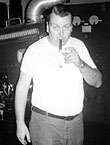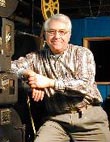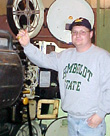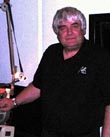|
|
This topic comprises 2 pages: 1 2
|
|
Author
|
Topic: carbon rods
|
|
|
|
|
|
|
|
|
|
|
|
|
|
|
|
|
Stan Gunn
Expert Film Handler

Posts: 176
From: Clematis, in the hills near Melbourne Australia
Registered: Aug 2000
|
 posted 02-18-2002 11:36 PM
posted 02-18-2002 11:36 PM





We in OZ had hundreds of small town cinemas set up in small halls useing AC arcs, there was also a power supply made for just that job.It just pluged into a standard power outlet (we have 240V 50 HZ as our standard supply).There were many C&W portable plants made with AC arcs running at 40 to 50 amps, being a portable supply they were of course called TRANSARCS some cinemas had a TRANSARC under the lamp as an emergancy supply, in case the main DC supply failed, some lamps would run on AC or DC.
There are still some being used on DC lamps,haveing had 4 diodes and a bit of C added, they make a good supply, the larger units able to run at 60 to 80 amps, they also made a good small arc welder. When running AC 50HZ arcs the projector speed was critical, but running at 25FPS was very common,no strobing and you got to go home a little earlier. 
------------------
KALEE FOREVER. CARBON ARC, THE ONLY LIGHT FOR THE STARS!
ALL PARTS FOR VICTOR AND KALART VICTOR 16MM PROJECTORS.SERVICE TO 35 AND 16MM PROJECTION EQUIPMENT.
35MM sprockets made to order.
| IP: Logged
|
|
|
|
Gordon Bachlund
Jedi Master Film Handler

Posts: 696
From: Monrovia, CA, USA
Registered: Aug 1999
|
 posted 02-19-2002 08:45 AM
posted 02-19-2002 08:45 AM





Mark, if a lamphouse uses carbons of the same diameter that burn at the same speed, the lamp is set up for AC operation. If a lamphouse uses a positive carbon that is of larger diameter, and often longer than the smaller diameter negative carbon (which burns slower), the lamp is set up for DC operation. The early Powers and Simplex projectors that I ran into in my youth, which were by then curious antiques, for the most part utilized DC lamphouses, most often fed from motor-generators. The 96-cycle AC lamps were, for all intents and purposes, a hiccup in the evolution of projector light sources. When I took my Los Angeles City projectionists license test in the early 1950s, the test consisted of two parts, a written exam and a hands-on skills evaluation, the latter being administered in the elderly nitrate booth of a City Hall auditorium. The lamphouses were so wired that either could, at the examiner's will, be fed DC or AC, and a part of the test was to determine which source was in use, it being understood that these were DC lamps and should not be burned on AC. The lamp on AC sputtered noisily and, of course, produced a strobe effect on the screen, while the lamp on DC burned quietly and produced a steady light. Thanks to having "devoured" Richardson and Cameron in my youth, I had no trouble distinguishing between DC and AC operation, and passed the test the first time around.
| IP: Logged
|
|
|
|
|
|
|
|
|
|
|
|
All times are Central (GMT -6:00)
|
This topic comprises 2 pages: 1 2
|
Powered by Infopop Corporation
UBB.classicTM
6.3.1.2
The Film-Tech Forums are designed for various members related to the cinema industry to express their opinions, viewpoints and testimonials on various products, services and events based upon speculation, personal knowledge and factual information through use, therefore all views represented here allow no liability upon the publishers of this web site and the owners of said views assume no liability for any ill will resulting from these postings. The posts made here are for educational as well as entertainment purposes and as such anyone viewing this portion of the website must accept these views as statements of the author of that opinion
and agrees to release the authors from any and all liability.
|

 Home
Home
 Products
Products
 Store
Store
 Forum
Forum
 Warehouse
Warehouse
 Contact Us
Contact Us




 Printer-friendly view of this topic
Printer-friendly view of this topic

















 I converted a few of them to xenon for a customer many years ago.........
I converted a few of them to xenon for a customer many years ago.........



